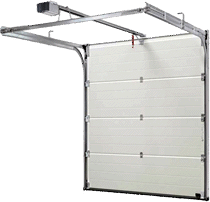Types of Garage Doors Express Garage Doors Toronto
 Swing-out carriage-house doors or sliding barn doors are a good choice if you need to keep the ceiling clear or if you want their distinctive look. Otherwise, the most popular option by far is the sectional roll-up door.
Swing-out carriage-house doors or sliding barn doors are a good choice if you need to keep the ceiling clear or if you want their distinctive look. Otherwise, the most popular option by far is the sectional roll-up door.
Before purchasing a roll-up door, measure the space between the top of the garage door opening and the ceiling or overhead framing. Standard tracks require headroom of about 14 inches. If you don’t have that, you can get low-headroom track, which costs about $100 more. There are also tracks specially made for garages with unusually high walls or cathedral ceilings.
Common Garage Doors Materials
Wood: Wood offers a charm and authenticity that other materials merely mimic. Wood doors can be made locally in whatever size you need, and they stand up well to bumps from basketballs. The downside is that they require frequent repainting or refinishing, especially if you live in a damp climate.
Wood garage doors range from midprice to very expensive, depending on whether they consist of a lightweight wooden frame filled with foam insulation and wrapped in a plywood or hardboard skin (the least expensive) or are true frame-and-panel doors made of durable mahogany, redwood, or cedar. Wood doors usually carry a short warranty, perhaps only one year.
Steel: Metal is a better choice than wood if you don’t want a lot of maintenance. Steel leads the pack because it is relatively inexpensive yet tough. Bare steel rusts, so you need to touch up scratches promptly, and steel also dents.
Minimize this risk by choosing doors with sturdy 24- or 25-gauge panels rather than 27- or 28-gauge (the higher the gauge number, the thinner the metal). Or consider a steel door with a fiberglass overlay, which resists dents and doesn’t rust. Fiberglass will need periodic repainting or restaining, though, because the color fades over time.
High-quality steel doors may have lifetime warranties on the hardware, laminations between the steel and any insulation, and factory-applied paint. Budget doors tend to have shorter warranties on some components, such as paint and springs.
Aluminum: Inexpensive aluminum garage doors, once common, have largely been replaced by sturdy versions with heavy-duty extruded frames and dent-resistant laminated panels. Rugged and rust-proof, these are a wonderful choice — if you can spend $10,000 or so on a garage doors.
Less expensive aluminum doors have aluminum frames and panels made of other materials, such as high-density polyethylene. Because of its light weight, aluminum is a good choice if you have an extra-wide double door; it won’t put as much strain on the operating mechanism.
Considering the size of a garage doors, it might seem obvious that you should invest in one that’s insulated. Because of its sandwich construction, an insulated door is more durable, and the enclosed back panel gives a garage interior a more finished look.
But the insulation won’t save energy unless you heat the garage or treat your attached garage as part of the “conditioned” part of your house. The federal Energy Star program recommends against doing this if you park cars, store lawn chemicals, or use solvents there because it could let dangerous fumes inside; it’s better to insulate only the shared wall and use that as the indoor-outdoor boundary.
